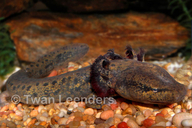|
Necturus maculosus (Rafinesque, 1818)
Mudpuppy, Common Mudpuppy | family: Proteidae subfamily: Necturinae genus: Necturus |
 © 2006 Twan Leenders (1 of 29) |
|
|
|
Description Two subspecies are currently recognized which differ in geographic distribution (see below) and coloration. The mudpuppy (N. m. maculosus, sometimes called the common mudpuppy) isrusty brown to grey dorsally, with a gray venter that ranges from unspotted to densely spotted. The Red River mudpuppy (N. m. louisianensis, sometimes called the Louisiana mudpuppy orwaterdog) is light yellowish brown to tan dorsally, sometimes with a dark dorsal stripe bordered by lighter stripes. The back and sides of the belly have large dark spots or blotches, but the midlineof the venter is light colored with no spots (Conant and Collins 1991; Petranka 1998). Distribution and Habitat Country distribution from AmphibiaWeb's database: Canada, United States U.S. state distribution from AmphibiaWeb's database: Alabama, Arkansas, Connecticut, Georgia, Iowa, Illinois, Indiana, Kansas, Kentucky, Louisiana, Massachusetts, Maryland, Maine, Michigan, Minnesota, Missouri, Mississippi, North Carolina, North Dakota, New Hampshire, New York, Ohio, Oklahoma, Pennsylvania, South Carolina, South Dakota, Tennessee, Virginia, Wisconsin, West Virginia Canadian province distribution from AmphibiaWeb's database: Manitoba, Ontario, Quebec
Life History, Abundance, Activity, and Special Behaviors Animals foraging on the bottom at night and retreat to burrows and cover during the day. Mudpuppies are active during winter months. Diet includes a range of aquatic invertebrates andvertebrates, including crayfish, annelids, snails, amphibians, fish, beetle and chironomid larvae, mayflies and caddisflies. Predators are poorly documented, but include water snakes (Nerodia).Humans are another source of mortality as fishers frequently discard mudpuppies on land when they are hooked (Pfingsten and White 1989; Petranka 1998) Trends and Threats Relation to Humans Comments
References
Ashton, R. E., Jr., Braswell, A. L. and Guttman, S. I. (1980). ''Electrophoretic analysis of three species of Necturus (Amphibia: Proteidae), and the taxonomic status of Necturus lewisi (Brimley).'' Brimleyana, 4, 43-46. Conant, R. and Collins, J. T. (1991). A Field Guide to Reptiles and Amphibians: Eastern/Central North America. Houghton Mifflin, Boston. Guttman, S. I., Weigt, L. A., Moler, P. E., Ashton, R. E., Jr., Mansell, B. W. and Peavy, J. (1990). ''An electrophoretic analysis of Necturus form the southeastern United States.'' Journal of Herpetology, 24(2), 163-175. Petranka, J. W. (1998). Salamanders of the United States and Canada. Smithsonian Institution Press, Washington D.C. and London. Pfingsten, R. A., and White, A. M. (1989). ''Necturus maculosus (Rafinesque). Mudpuppy.'' Salamanders of Ohio. Pfingsten, R. A., and F. L. Downs, eds., Ohio Biological Survey, Columbus, OH, 71-78. Shoop, C. R. (1965). "Aspects of reproduction in Louisiana Necturus populations." American Midland Naturalist, 74, 357-367. Originally submitted by: Meredith J. Mahoney (first posted 2000-07-27) Edited by: M. J. Mahoney (2001-05-09) Species Account Citation: AmphibiaWeb 2001 Necturus maculosus: Mudpuppy <https://amphibiaweb.org/species/4226> University of California, Berkeley, CA, USA. Accessed May 13, 2025.
Feedback or comments about this page.
Citation: AmphibiaWeb. 2025. <https://amphibiaweb.org> University of California, Berkeley, CA, USA. Accessed 13 May 2025. AmphibiaWeb's policy on data use. |




 Raffaëlli Account
Raffaëlli Account Map of Life
Map of Life